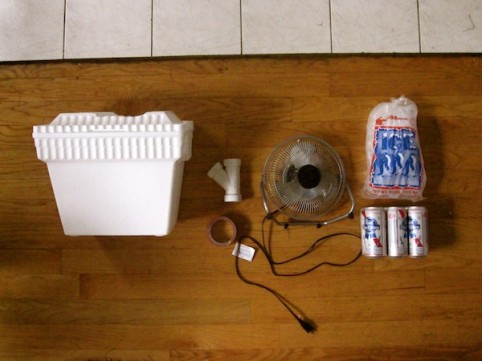
There are few sentences in the English language less believable than “I’m going to build my own air conditioner.” The amount of daring and hubris required to even utter such a phrase is rare enough to be found only in the very smart, or the very stupid. But it’s hot, dammit, and desperate times are calling for desperate measures. The rent is too damn high, and the weather is too damn hot — surely there must be a solution to this.
It’s only August, and the season isn’t over yet. And so, now in the summer of our discontent, the time has come to put ingenuity to the test, to throw both caution and reason into the wind and to laugh loudly in the face of ConEd. If global warming is a scientific problem, one has no choice but to propose a scientific solution: the DIY air conditioner. Several models are floating around the internet. But do they work?
IS THIS A THING PEOPLE ACTUALLY DO?
Research — also known as Internet rumors — suggests that it is possible to build your own air conditioner for about $30-40. The idea originated when an unnamed university forbid students from having air conditioners in their dorm rooms, and a group of enterprising young people took it upon themselves to defy this rule and build one themselves. This story has been floating around Lifehacker since 2005, and has since been revamped twice by increasingly enterprising and decreasingly sweaty young college students.
Unsurprisingly, the definition of “air conditioner” in these circumstances is a bit loose, expanded vaguely to “something that blows cold air.” Their model was built off the idea of a “swamp cooler,” which relies on the evaporation of water rather than vapor compression to cool the air that it circulates, or at least that’s what Wikipedia says.
THE OPTIONS
Since the initial attempt (which was apparently successful), there have been a number of elaborations and variations on the process, ranging from a wet shamwow behind a box fan to an electrified ice chest to a double-bucket gravity contraption that only god and nerds know how to assemble. The options are endless, and a little bit daunting for someone who doesn’t even own a screwdriver.
OK, HOW DO YOU BUILD THE DAMN THING?
As previously mentioned, some designs for the A/C are more complex, requiring pumps and copper wire. Others relied on gravity to get the job done. This one requires something called a Seachoice bilge blower, which sounds difficult to acquire and maybe even a little gross.
The chosen candidate for this experiment is the redneck air conditioner, brought to us by the reliable folks filming themselves doing reasonable things on YouTube. The idea is that the fan will blow air into the cooler, and the ice will cool the air before funneling it out through the pipe elbow. And there you will have it: air conditioner.
The materials
• 1 Styrofoam cooler ($6)
• 1 Pipe elbow ($3)
• 1 Fan ($15)
• Ice ($1)
• Beer, optional ($10)
Total: $35
ASSEMBLING YOUR A/C
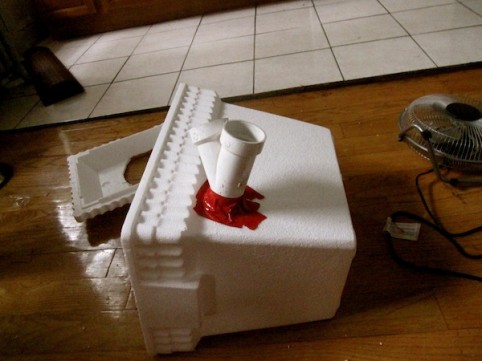
Step 1: Purchase materials
The Home Depot ran out of fans, which is both stupid and funny as well as scary and possibly apocalyptic. Maybe you are somebody who already has a fan. Maybe your fan fortress is the reason that Home Depot no longer has any. If that’s the case, good on you – you’re saving money on this part of the project. As far as everything else is concerned, the Styrofoam cooler was acquired from a Rite Aid, and the rest of the materials came from bodega-style hardware stores.
Step 2: Cut two holes in the Styrofoam container, one on the side for the pipe elbow, and another on the top for the fan. Place fan and pipe in respective openings. Secure the openings with duct tape. Red duct tape earns extra urgency points.
Step 3: Fill the container with ice, and maybe beer if you feel so inclined.
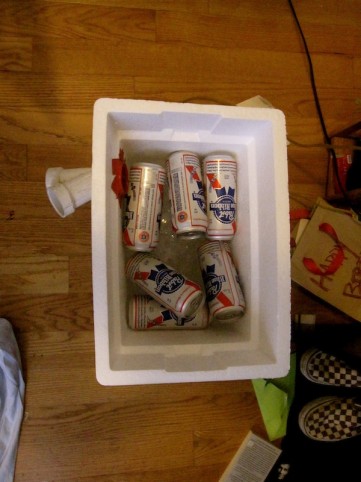
Step 4: Replace the lid of the container and turn the fan on.
Step 5: Grab a beer, leave the room, and let the cooler do its thang.
RESULT?: ACTUAL HOT MESS
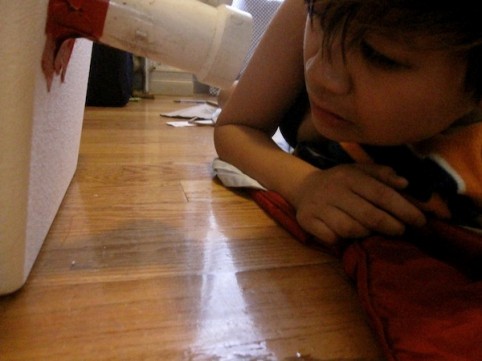
Okay, so, show of hands: who’s surprised this didn’t work? After half an hour of waiting for the magic to happen, it soon became apparent that probably only magic — not science — could coax cold air out of this contraption. It might be a bit of an exaggeration to say that this DIY A/C unit actually made the room hotter, but between closing the window and the door and funneling the fan’s full windpower through a tiny tube, it’s entirely possible that it actually did. On top of that, the ice was quick to melt and would have been put to better use in glasses of water or perhaps even that kiddie pool you almost threw away.
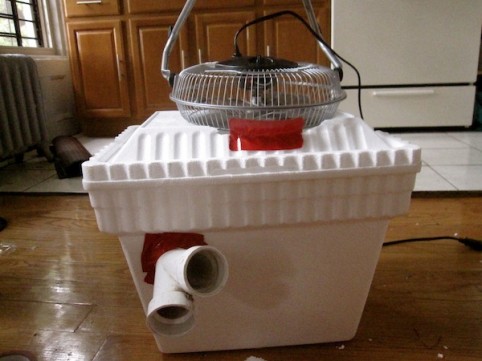
Are there improvements, tweaks and tricks that could bring this idea to life? Probably. But let’s be real here: if air conditioners were easy, everyone would have one. If you’re still desperate during these last long legs of summer, you could hunt around for a cheap A/C unit, which you could probably swing for about $70. Not only is that the cost of about two of these DIY versions, it would probably blow around at least twice as much hot air.
For the rest of us, it’s game over. Myth busted. There’s only one more month of summer left, and we’ll live through it like we always do, even if it means spending at least half of it building a tent in front of the freezer.
Follow Katrina through her furthering sweaty adventures: @kcdanger.
13 Comments
Leave a Reply

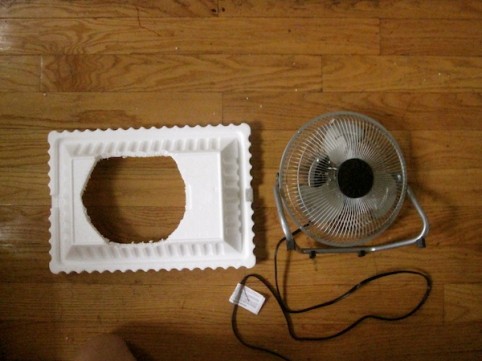



Wow, u r incredibly inept
poor girl..at least she tried. I don’t think the design was that great to begin with…with a better setup they actually do work
The design was bad and I think the fan choice was poor as well. Another issue is that you added something already warm/room temperature to the ice.
You need to build the kind with the copper tubing in front of the fan, and the tubing runs into the ice chest. A pump moves water through the piping. That is a proper swamp cooler.
My wife and I had to move in with her grandparents after her grandmother broke her foot. Long story short, the ac is designed for a house half it’s size and our area of the house stayed at about 90* when the outside temp was 85*. I built one of these. Took our bedroom from 88* to 75* in 20 minutes. But the ice only lasts about 4 hours. We fixed this by freezing gallon jugs of extremely salty water. Put a jug in the cooler and it lasts about 8 hours. And once it ran for a few hours, the temp got to about 73*. If I put both of our jugs in the cooler, the bedroom gets to about 69* and lasts about 10 hours.
Excellent idea about using plastic water jugs. I’m building one of these right now, and your tip makes it all work. Thanks.
Two of the same contraption should keep you cool all night. But of course you have to have a timer to turn on the second one if you don’t want to break sleep.
You’re doing it wrong. As Kyuta said, you don’t want to put warm things in the cooler, that will just equalize with the ice and defeat the whole purpose. Also the way you have the beer cans shown in the picture they are almost completely covering up the ice therefore the air will flow over the top of the warm cans and out the exhaust, not interfacing well with the ice. The goal is to maximize surface area of air flow through the ice which will cool the air quicker before it goes out the exhaust. Ideally you would have the cooler completely full with ice (exhaust vents coming out the top not the side), and as an enhancement you could insert something to serve as a wall or tunnel under the fan which forces the air the travel all the way to the bottom of the cooler before making a u-turn and going up through more ice (on the other side of the “wall”) before exiting. Because you want to maximize the surface area of heat transfer, it may be beneficial to periodically drain the water out (so more ice surface area is exposed), especially if you add the “wall” enhancement mentioned. I’ve seen some people use ice packs, but then you would have to invest more money for enough ice packs to fill the cooler. Finally, the cross-section of your exhaust is significantly smaller than the fan inlet. While in theory this could result in faster airspeed at the exhaust, in practice it likely resulted in over-pressurizing your cooler and led to air leaking out the lid or just restricting the airflow of the fan in general. Most designs I have seen have 2 exhaust ports (on the top) for one fan, and using larger diameter exhaust pipe than you have pictured (such as dryer exhaust duct which may be cheaper than large diameter PVC). You should try to make the total exhaust cross-sectional area roughly equivalent to the inlet fan cross-sectional area (remember, for a circle, Area = Pi*r^2).
I should disclose that I have not actually built one of these yet (I may later tonight; AC busted and am still waiting for the replacement under warranty). My comments are based on my general knowledge of Engineering and heat transfer fundamentals.
Fill it to the brim with ice and put the exhaust on top. Works well in a small room.
As has been said, “Yer doin’ it wrong.”
First of all, if you build it half-assed, you’ll get half-assed results.
Second of all, it’s cold air, not magic. If you leave the room and don’t come back until all the ice melts, then yes, the room will be hot again. Your contraption only blows cold air while it has something cold to blow air through. That’s just common sense.
lol they put some can(conductor) and expect the air conditioner to work
I was really amazed when i came across this stuff some days back at my friend’s place. Very cool and inexpensive. I got mine from https://www.etsy.com/listing/242970774/5-gallon-bucket-air-conditioner-3-pvc
Nice tutorial.